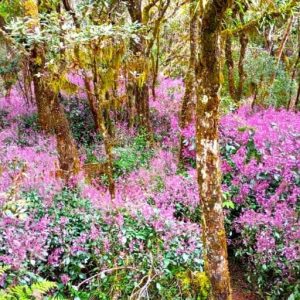COLOMBO — Every dozen years or so, Sri Lanka’s mist-shrouded highlands burst into color. Violet, pink and white carpets of tiny blooms spread across the grasslands of the Horton Plains and other hill country trails, drawing thousands of visitors eager to witness one of nature’s rarest spectacles: the mass flowering of nelu, a group of native shrubs belonging to the genus Strobilanthes, known for synchronized mass flowering occurring every 4-12 years. Strobilanthes shrubs bloom together, set seed and then die, transforming the landscape in a breathtaking but fleeting display of sheer floral beauty. Yet, behind this beauty lies a scientific mystery. These plants flower so rarely and in a perfectly synchronized manner. It only adds to the allure of this natural wonder, even as crowds flock to see the floral carpets, exerting new pressure on the fragile montane ecosystem. Sri Lanka is home to 35 nelu species, where 30 of them are endemic to the country, however, only a few species contribute to the scenic mass blooming. Image courtesy of Jinapriya Gallage. What is nelu? “Nelu” is not a single species but a group of shrubs belonging to the genus Strobilanthes in the Acanthaceae family, which includes hundreds of species across tropical Asia. Sri Lanka is home to 35 Strobilanthes species, of which 30 are endemic, with a majority of them found only in the island’s Central Highlands, says Nilanthi Rajapakse of the Department of Wildlife Conservation (DWC), whose studies led to discovery of three nelu species new to science. Different…This article was originally published on
Mongabay
